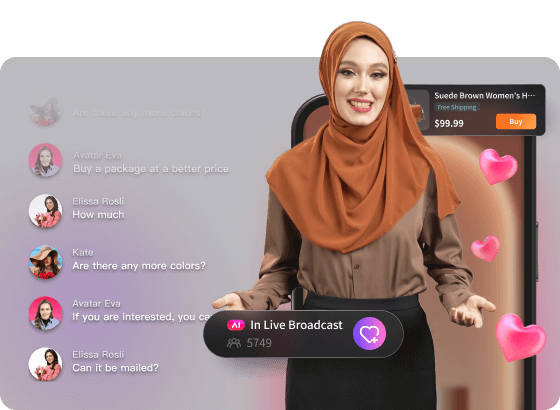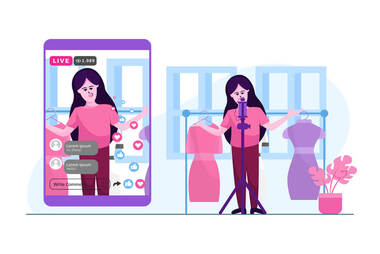Live selling is revolutionizing the e-commerce landscape, offering a dynamic and engaging way to connect with customers in real time. In this article, we’ll explore what live selling entails, provide essential tips for success, and delve into the future trends shaping this innovative approach. Whether you’re new to live selling or looking to refine your strategy, this guide will equip you with the knowledge and tools to harness the power of live selling and stay ahead in the competitive online marketplace.
What is Live Selling?
Live selling, also known as live shopping or live commerce, is an e-commerce method where sellers showcase and sell products through live video broadcasts. During these live sessions, hosts demonstrate products, interact with viewers in real-time, answer questions, and offer special deals. Viewers can purchase products directly from the live stream, often with a seamless buying process integrated into the platform.
The Rise of Live Selling
Live selling rose primarily through its origins in China, with platforms like Taobao Live in 2016 leveraging influencers and Key Opinion Leaders (KOLs) to drive sales. The COVID-19 pandemic accelerated its global adoption as consumers and businesses turned to online shopping. Western platforms like Facebook, Instagram, and Amazon soon integrated live selling features. Technological advancements made it easier to purchase directly within live streams, enhancing user experience. Celebrity endorsements and participation from major brands further popularized live selling, blending entertainment with commerce and creating a more engaging, interactive shopping experience.
Online Live Selling Tips
Be good at using tools
Choosing a good third-party live streaming software can make your live streaming easier and more efficient. There are many options on the market, such as OBS, Restream, and Streamlabs, which can meet most of your needs. However, using advanced tools like BocaLive can dramatically reduce costs and increase efficiency. Here’s why:

Features of BocaLive:
- AI Avatars: Use AI avatars instead of real people to stream, with the ability to respond to comments and interact with viewers in real-time.
- Cost-Effective Setup: No need to spend a lot of money on equipment and scene building. Utilize system templates to quickly create a beautiful live broadcast room.
- AI Text-to-Speech: Effortlessly generate scripts with built-in AI. Create engaging live scripts automatically by pasting product links and switch seamlessly between 29+ languages.
- Multi-Platform Streaming: Stream simultaneously across various platforms, including YouTube, Facebook, LinkedIn, Alibaba, TikTok, and more.
- Multi-Room Live Stream: Operate up to 6 live broadcast rooms from a single computer, facilitating matrix live broadcasting with ease.
- Custom AI Avatar: For a more personalized image, upload your own video to generate a custom AI avatar for live streaming.
Using BocaLive, you can enhance your live streaming experience, reduce costs, and increase efficiency, making it a superior choice among live streaming tools.
Get the rhythm right
Timing is Key: Establish a consistent schedule for your live sales to build anticipation and routine among your audience. Regular timing helps in creating a loyal viewership that knows when to tune in.
Pace Your Presentation: Balance between demonstrating products and engaging with the audience. Avoid rushing through products or dragging out sections too long. A well-paced live stream keeps viewers interested and reduces the risk of drop-offs.
Engage Continuously: Keep the energy up throughout the live session. Use interactive elements like Q&A sessions, polls, and shout-outs to maintain viewer interest and interaction.
Serve customers well
Respond in a timely manner and solve audience questions and comments in real time. A quick and accurate response can enhance trust and encourage purchases. Provide detailed demos and comprehensive information about the product. Showcase different angles, features, and usage scenarios to give the audience a clear idea of what they’re buying. Don’t forget to follow up with the service, and after the live stream, make sure to follow up with the customer. Send thank-you messages, confirm orders in a timely manner, and provide excellent after-sales support to create long-term relationships.
Collaborate with influencers
Leverage Their Reach: Partnering with influencers can significantly boost your live selling events. Influencers bring their loyal followers, increasing your exposure and credibility. But remember, don’t overdo it, or you’re likely to have the opposite effect.
Choose Relevant Influencers: Select influencers whose audience aligns with your target market. Their endorsement can lead to higher trust and conversion rates among their followers.
Co-Host Events: Invite influencers to co-host live sessions. Their presence can make the event more engaging and attract more viewers. Collaborate on special promotions or exclusive deals to make the session more appealing.
Best Time for Live Selling
Generally, the evening hours are the time to increase sales opportunities. Nights are more likely to arouse people’s desire to consume. Specifically, you can judge the best time for your live stream sales based on the following points:
Know Your Audience: Understand the habits and schedules of your target audience. Analyze data to determine when they are most active online and likely to engage.
Test Different Times: Experiment with different times and days to find the optimal slot for maximum viewership. Pay attention to peak hours on various platforms.
Consider Global Audiences: If you have an international audience, consider timing your live sessions to accommodate different time zones. Scheduling at a time that works for multiple regions can broaden your reach.
The Future Trend of Live Selling
The future of live shopping is set to evolve with significant advancements, particularly through integration with artificial intelligence (AI). Digital humans will play a vital role in the live shopping experience. Digital humans, also known as virtual humans or avatars, are computer-generated characters that can interact with real people in real-time during live streams.
They can interact with the audience in a lifelike way, responding to comments and questions in real-time. Digital humans can also collect and analyze data to provide valuable insights into audience preferences, engagement patterns, and purchasing behavior. This data can be used to refine marketing strategies and improve future live sessions. Unlike humans, digital humans can operate around the clock without fatigue, enabling brands to engage with audiences anytime, anywhere, across time zones, and deploy multiple digital humans simultaneously across various live streaming platforms to reach a wider audience without human resource constraints. Digital humans can reduce the costs associated with hiring, training, and managing human hosts. Once created, they can be reused with minimal additional cost.
Integrating AI into live streaming is changing the landscape by making it more interactive, scalable, and cost-effective. As technology advances, digital humans will play a key role in creating more engaging, personalized, and innovative live streaming experiences. However, the use of AI is prone to raising ethical questions about authenticity and transparency, and brands must consider ethical factors to ensure transparency and maintain the trust of their audiences.
FAQs of Live Stream Selling
What does live selling mean?
Live selling is an e-commerce method where products are showcased and sold through live video broadcasts. During these sessions, hosts demonstrate products, interact with viewers in real-time, answer questions, and often offer special deals. Viewers can purchase items directly from the live stream through integrated shopping features. This approach combines the immediacy and engagement of live interaction with the convenience of online shopping, creating a dynamic and personalized shopping experience that can drive higher sales and customer engagement.
How to start live selling?
To start live selling, first, choose a platform like Facebook Live, Instagram Live, or a dedicated app process like Popshop Live. Get ready by choosing the products you want to showcase and setting up a well-lit, engaging backdrop. Prepare attractive live scripts to promote your live event in advance through social media and email marketing. During the live stream, engage with your audience by showcasing products, answering questions, and offering special offers.
How long should a live sale be?
Live sales should usually last at least an hour. This allows plenty of time to showcase multiple products, interact with the audience, answer questions, and create a sense of urgency without overwhelming the audience. Shorter sessions may not provide adequate interaction or product reach, while longer sessions may lose audience interest. The key is to maintain a dynamic and engaging flow that ensures that the content remains interesting and that the audience remains engaged throughout the live sales process.
Final Thoughts
As live stream sales continues to evolve, staying ahead of trends and mastering effective strategies is critical to success. The future of live selling is bright, and by leveraging the tips, advanced AI-powered live streaming tool BocaLive, you can enhance your live sales efforts and drive greater engagement.





Recent Comments